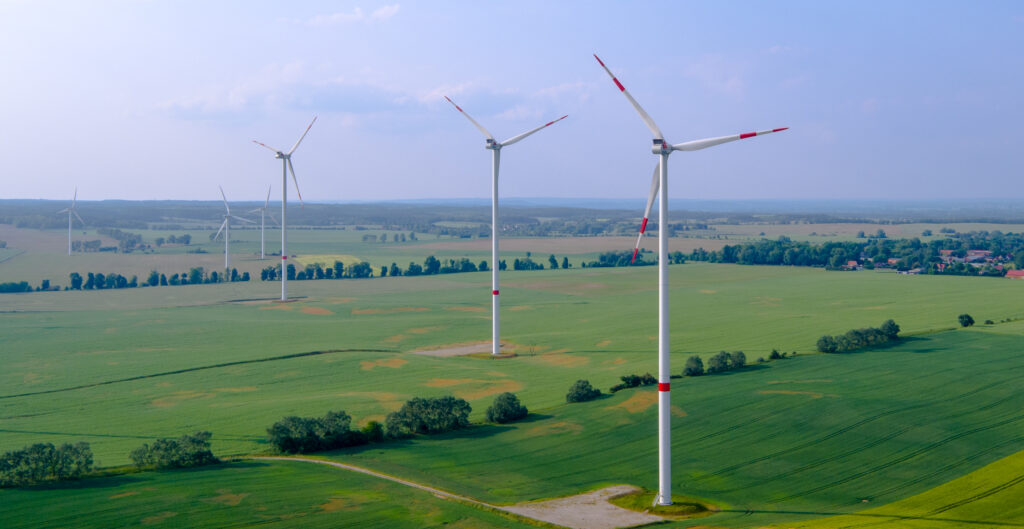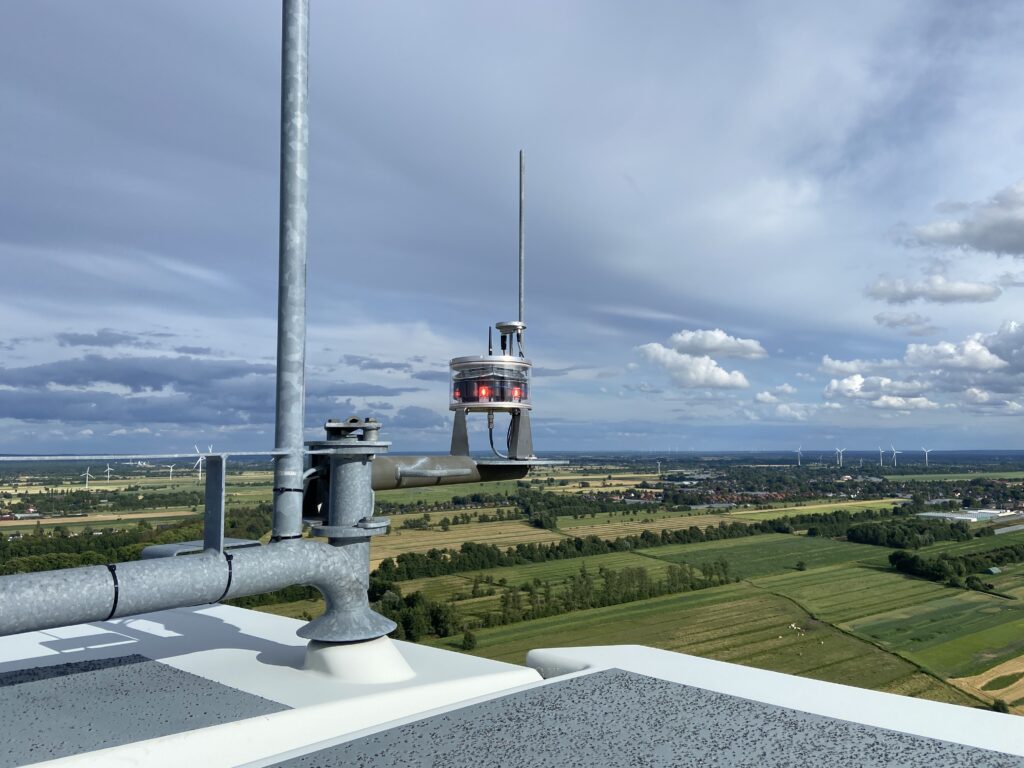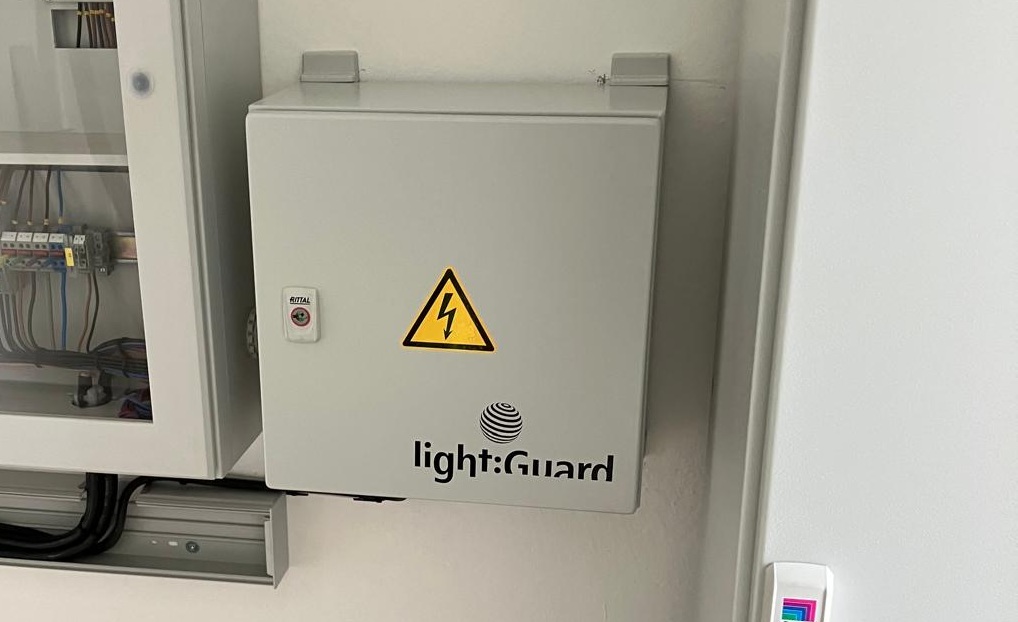2. June 2025
Light:Guard » News » Case study: ADLS reduces lighting by over 90% at Lüdersdorf wind farm
Case Study
The Lüdersdorf wind farm is located in the municipality of Wriezen in Brandenburg, approximately 50 km northeast of Berlin. It consists of three Vestas wind turbines with a total rated output of 11.6 MW. There are three airfields in the immediate vicinity.
Due to the legal obligation under the Renewable Energy Sources Act (EEG), the light:guard Aircraft Detection Lighting System (ADLS) was installed. The ADLS uses transponder signals and multilateration to detect the position of flying objects. The wind farm’s lighting is only activated when an aircraft is in the vicinity. This reduces nighttime light pollution while ensuring safety for air traffic.
The switch-on and switch-off times of the lights at the Lüdersdorf wind farm were analyzed over a six-month period from September 2024 to February 2025. The average light-off time was 92.61%, despite high flight activity in the area due to the adjacent airfields. The proportion of light-on time and errors was minimal, which speaks for the high quality of the system.
The Lüdersdorf wind farm is located in the municipality of Wriezen in Brandenburg, approximately 50 km northeast of Berlin. It consists of three Vestas wind turbines with a total rated output of 11.6 MW. There are three airfields in the immediate vicinity:
Since January 1, 2025, the use of Aircraft Detection Lighting Systems (ADLS) on wind turbines has been mandatory in Germany. This requirement stems from the Renewable Energy Sources Act (EEG) and non-compliance will result in heavy fines. The regulation was introduced to protect people and nature from unnecessary light pollution caused by wind power.
Aircraft Dection Lighting Systems reduce the flashing of wind turbines to a minimum. The system monitors the airspace around a wind farm. When an aircraft approaches, it lifts the suppression of the lighting and the red light flashes as before.
The challenge here is to flash as little as possible while ensuring sufficient safety for aviation. Especially in areas with high air traffic, the ADLS must work very accurately in order to achieve the desired effect and ensure dark nights.
In February 2024, the light:guard Aircraft Detection Lighting System was put into operation at the Lüdersdorf wind farm. The system uses transponder signals from flying objects to determine their location.
Light:Guard relies heavily on multilateration. This involves the signal being received and processed by several receivers, which allows not only the exact location but also the flight path to be determined. This enables precise detection and the flashing to be switched on as required.
The airspace northeast of Berlin is covered by many Light:Guard receivers, making multilateration possible in this area.
Six months from September 2024 to February 2025 were considered for the analysis of the lights-on and lights-off times of the lights.
The average lights-off time was 92.61%, despite high flight activity in the area due to the adjacent airfields. The proportion of light-on time and errors was minimal, which speaks for the high quality of the light:guard system.
Air traffic was particularly high in February 2025, with 828 detections. This means that the ADL system detected a flying object more than 30 times per night and activated the flashing of the wind turbines. As a result, the lights-off time in this month was “only” 80.29%.
However, this is still a good figure, which is even surpassed by the results for other months. In January, for example, despite 455 detections, the flashing was switched off for over 94% of the time, see Figure 3. Table 1 shows the percentages when the flashing was on and off.
Satisfied with the results

„Thanks to the Aircraft Detection Lighting System, we not only fulfill our legal obligation, but can also be a good neighbor to the local population. With Light:Guard, we have chosen the right partner. Thanks to their system, the nights in Lüdersdorf are dark.”
Daniela Beyer, re:cap global investors ag
„The Lüdersdorf wind farm was one of our first ADLS projects. re:cap and we did a lot of pioneering work with a new technology. It's great that we can repay the trust placed in us with good results.“
Jon Galdeano, Project Manager at Light:Guard

From the German experts – for your wind turbines. Contact us now for a non-binding offer!
The steps to the dark wind farm
The Lüdersdorf wind farm is being built and goes into operation.

re:cap commissions ADLS from Light:Guard. The offer includes upgrading the lighting, obtaining approval, and equipping the facilities with the light:guard system.
The wind farm is being upgraded, i.e. prepared for the use of an Aircraft Detection Lighting System. The old lighting system – the flashing lights – is being replaced with infrared and communication-enabled lamps.

The light:guard system is being installed at the Lüdersdorf wind farm. A Light Control Unit, which controls the lighting in the park, and a Light:Guard Receiver for receiving transponder signals are being installed.

The wind farm is surveyed and provides site-specific proof of functionality. Transponder signals are sent to the receiver, simulating a flying object. Only then can ADLS be approved and activated.
The authorities have given their approval and the turbine manufacturer forwards the signal. The light:guard system is active and the lights in the park are off. The Lüdersdorf wind farm now has a functioning Aircraft Detection Lighting System.
Your personal contact